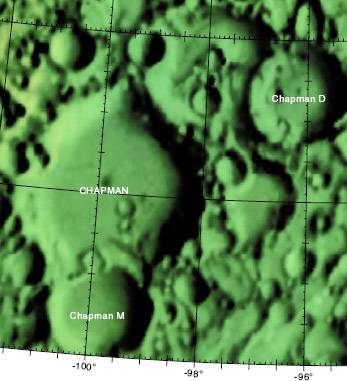Chapman
Contents
Chapman
|
Lat: 50.4°N, Long: 100.7°W, Diam: 71 km, Depth: km, Rükl: (farside) [/Stratigraphy pre-Nectarian] | |
Table of Contents
Images
LPOD Photo Gallery Lunar Orbiter Images
- Chapman was captured in Lunar Orbiter IV's frame LO-IV-190-med, south of Poczobutt, not far from the local morning terminator.
Research Lunar Orbiter IV photography: Danny Caes
Maps
([/LAC%20zone LAC zone] 21D3) USGS Digital Atlas PDF
Description
Chapman lies some ~ 400 km away west of the main region that makes up part of the northern section of [/Oceanus%20Procellarum Oceanus Procellarum], and some ~ 1800 km in the same direction from the [/Imbrium%2C%20Mare Imbrium Basin]. As the crater is [/Stratigraphy pre-Nectarian] in age (~ 4.6 to 3.92 bn years), it has taken on the usual, well-worn appearance of a hard-to-define rim, collapsed internal wall sections covered in numerous impact craters (big and small), and a flat floor showing signs of a central peak that once existed. Most of the crater's northern, eastern, and north-eastern sectors has survived any major alteration through impacts, however, the southern sector wasn't so lucky; producing the crater, Chapman M, whose event has totally obliterated all remnants of Chapman's rim there. Moreover, the south-western sector also show signs of being affected by some event or other, however, it's not quite claer as to what is involved. One might be satisfied with this description above of the crater, however, the enormous impact (pun included), of the above-mentioned Imbrium Basin must surely be responsible for most of the effects on the crater that we see today.- JohnMoore2 JohnMoore2
Description: Wikipedia
Additional Information
Nomenclature
- Named for Sydney Chapman (January 29, 1888 – June 16, 1970), a British mathematician and geophysicist. Chapman studied magnetic storms and aurorae, developing theories to explain their relation to the interaction of the Earth's magnetic field with the solar wind.
- Chapman was in the long list of farside names approved by the IAU in 1970 and published in [/Menzel%2C%201971#Chapman Menzel, 1971].
- A valley running over the southern rim of Chapman D is unofficially called Vallis Chapman D by - DannyCaes DannyCaes Nov 1, 2010.
LPOD Articles
Bibliography
A curiosity...
Not at all related to Sydney Chapman and/or the moon's farside crater known as Chapman, but... maybe it's interesting to know something about the presence of the name Clark Chapman in the Sourcebook Project of William R. Corliss, at page 181 of Mysterious Universe, a handbook of astronomical anomalies, 1979. See the article A Remarkable Eclipse of the Moon (Sky and Telescope, 1964). Now, is this Clark Chapman the same person as Clark Chapman of the B612 Foundation? - DannyCaes DannyCaes Apr 11, 2015
Sydney Chapman in the Sourcebook Project (William R. Corliss)
- In Rare Halos, Mirages, Anomalous Rainbows, and related electromagnetic phenomena (1984) :
- GEZ5-R5: Meteor Geomagnetic Effects (Sydney Chapman and Attia A. Ashour, Smithsonian Contributions to Astrophysics, 1965) (GEZ5: Meteor Activity Correlated with Geomagnetic Activity).
- In Lightning, Auroras, Nocturnal Lights, and related luminous phenomena (1982) :
- GLA4-R16 and GLA21-R5: The Audibility and Lowermost Altitude of the Aurora Polaris (S.Chapman, Nature, 1931).
- GLA4-R19: Low Altitude Aurorae (S.Chapman, Nature, 1932).

